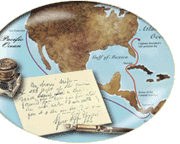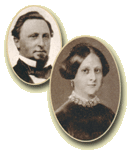

 |
 |

|
Fortunes in hand, many speculators decided to return to their homes on the East Coast. The route taken most frequently took
Sailing east, with treasureOn August 20, 1857, several hundred passengers in San Francisco boarded the SS Sonora, of the Pacific Mail Steamship Line, and headed south toward Panama City. Aboard was over 1.6 million dollars in (1857 value) gold—thousands of freshly minted 1857-S double eagles, some earlier $20 coins, ingots, and gold in other forms. Some of the double eagles were stacked in long rows or columns and nestled in wooden boxes. Elsewhere around the ship, passengers had their own treasure—purses and boxes reflecting their success in the land of gold, the new El Dorado.
When the train arrived in Aspinwall, the passengers alighted, and the treasure was carefully transported to storage. The SS Central America heads for New YorkThe next leg of the trip was aboard the side-wheel steamer SS Central America, earlier known as the SS George Law, now on its forty-fourth voyage for the Atlantic Mail Steamship Company.
In early September 1857, the gold treasure was carefully packed aboard, passengers found their cabins and berths, and all were ready for the pleasant voyage to New York City. The time of year was ideal for travel. A few days later, on September 7, 1857, the ship docked in the harbor of Havana, a popular stop for buying souvenirs and exploring the sights of the town. The trip continued to be pleasant, with sunny skies overhead, puffy clouds here and there, and smooth seas. Onward through the AtlanticIn the late 19th century, weather forecasting was not scientific. Little was known about tropical storms, their frequency,
and how to predict them. Distinguishing between a gale or
small storm and the beginnings of a major hurricane was
nearly impossible. Few people knew the history of the area,
including the fact that in the years 1715 and 1733,
devastating hurricanes had sent virtually entire fleets of
Spanish galleons to the bottom of the sea off the coast of
Florida. their frequency,
and how to predict them. Distinguishing between a gale or
small storm and the beginnings of a major hurricane was
nearly impossible. Few people knew the history of the area,
including the fact that in the years 1715 and 1733,
devastating hurricanes had sent virtually entire fleets of
Spanish galleons to the bottom of the sea off the coast of
Florida.
At 5:30 a.m. on Wednesday, September 9, the ship’s second officer noted that the ship had gone 286 nautical miles in the preceding 26½ hours, and that there was a fresh breeze kicking up swells. Perhaps a storm was coming. In any event, there was no alarm. This was a large ship, well equipped, and with an experienced crew capable of handling any storm. Wind and wavesAs the hours passed, the breeze intensified to a strong wind, finally reaching gale force. The SS Central America was tossed about in the waves, but continued on her course. Card games, reading, and other amusements in the finely appointed parlors came to an end. Many seasick passengers huddled in their cabins that afternoon and into the night, waiting for the wind to subside and looking forward to a bright morning.The expected calm did not come. By daybreak on Thursday, conditions had worsened, wind was screaming through tattered sails and rigging, passengers remained below deck, and the SS Central America was in the middle of a raging hurricane. Throughout the day the fury of the storm and wind-whipped waves increased, but the ship remained watertight and the engines functioned properly. Instead of subsiding, the fury of the storm continued to increase. High winds and waves wracked the ship, and it was all the captain could do to keep the bow headed into the waves.
|
||||||||